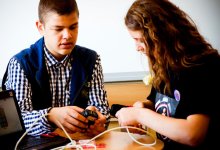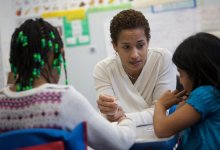Collaborative Learning
Working together to solve problems and complete projects deepens students’ learning and builds collaborative skills. Learn how to design activities to help develop these skills.
The Benefits of Anti-Models for Boosting Learning
Teachers can explore with students what not to do—like confusing operations in math or using boring word choices in writing—to set students on the right path and boost learning.How Classroom Jobs for Teens Instill Responsibility
When middle and high school students take ownership of tasks in their classroom regularly, they build a culture of teamwork and support.Your content has been saved!
Go to My Saved Content.Giving Students Time and Confidence to Build Their Metacognition Skills
A high school teacher subtly encourages students to develop an appreciation for the “in-between” steps on the path of learning.Your content has been saved!
Go to My Saved Content.Improv in the Classroom
A collection of our popular articles and videos about how theater games and improvisation can spark creativity, build relationships, and boost academics and executive function skills alike.5.7kYour content has been saved!
Go to My Saved Content.Exploring Narrative Elements Through a Drama Game
Using an improv exercise to practice the parts of a story gets ideas flowing for students—and helps them add structure to their writing.Activating Learning by Milling to Music
When students pretend they’re at a fancy party making small talk, a simple brainstorm for writing ideas becomes more lively, more cooperative—and more effective.21.7kYour content has been saved!
Go to My Saved Content.16 Variations on Think-Pair-Share to Keep Students Engaged
Teachers and students use this classic learning strategy often. To keep it from getting stale, try these tweaks.22 Powerful Closure Activities
Quick activities that can be used to check for understanding or emphasize key information at the end of a lesson.55.8kYour content has been saved!
Go to My Saved Content.60-Second Strategy: Whiteboard Relay
The team competition is fierce in this informal assessment activity, in which students have to work together to win.8kYour content has been saved!
Go to My Saved Content.60-Second Strategy: Respond, Reflect, and Review
This simple activity helps students practice giving and receiving peer feedback—and gets them out of their desks.15.8kYour content has been saved!
Go to My Saved Content.Student-Centered Learning: It Starts With the Teacher
Teachers encourage student-centered learning by allowing students to share in decisions, believing in their capacity to lead, and remembering how it feels to learn.24.4kYour content has been saved!
Go to My Saved Content.8 Closing Activities to Wrap Up a Lesson
Lock in the day’s learning with these closing activities that check for understanding and clear up misconceptions.Golden Rules for Engaging Students in Learning Activities
Six factors to consider in designing lessons to help increase student engagement behaviorally, emotionally, and cognitively.22.4kYour content has been saved!
Go to My Saved Content.3 Activities to Support Student Voice in Math
Discussing problem-solving techniques and famous mathematicians helps elementary students learn math concepts.235Your content has been saved!
Go to My Saved Content.60-Second Strategy: Cooperative Learning Roles
Giving students randomly assigned roles in their group work helps ensure that they all participate.13.6kYour content has been saved!
Go to My Saved Content.











